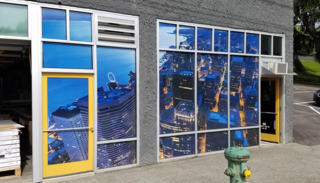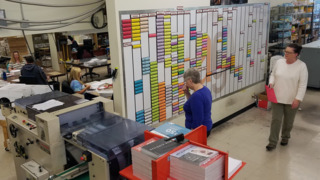2017 Annual Top 100 Quick & Small Commercial Printers
Our ranking of the Top 100 quick and small commercial printers includes firms you’ll recognize as well as several newcomers.

The year 2016 was, overall, a good year for quick and small commercial printers, as this year’s Top 100 companies indicate. Total sales figures – nearly $568 million – were up more than 11% versus 2015 sales, and nearly 25% of the Top 100 firms report double-digital sales growth for last year.
So there’s reason for great optimism for the market. As Chuck Stempler, president/CEO of Alphaprint Inc, DBA AlphaGraphics Seattle (#3 in this year’s Top 100), indicates: “There is an excellent future opportunity for those with a strong balance sheet, vision for the future (products/services), and a willingness to invest in the development of their team to bring it to reality in the service of their clients.”
Evolving the sales model
Coming in at the #1 spot this year: Firespring Print, headquartered in Lincoln, Nebraska. The company formerly branded as Cornerstone Print & Marketing had landed at the #2 slot in last year’s Top 100 and the #6 slot in 2015. So the firm is definitely on the right success track.
Kevin Thomas, Firespring’s chief operating officer, notes that his firm’s success has been a product of ensuring that what they offer isn’t just simply about price: “As we have grown, we have continued to find ways to differentiate ourselves from competitors – evolving the sales model from a commodity-based buying cycle to one that allows for consultative strategy. For many projects, with online competition, there is always someone way cheaper than us. So, unless we can prove to the client why our product is either better or different, it's all about the price. We are trying to stay out of the arms race for the cheapest product offering,” says Thomas.
Rounding out the top 10 in this year’s Top 100 are:
- Ironmark (2);
- AlphaGraphics Seattle (3);
- Tapecon Inc. (4);
- Nordis Technologies (5);
- Strategic Factory (Miller’s Minuteman Press) (6);
- Mele Printing (7);
- Allegra Marketing Print Mail Plymouth (8);
- Sir Speedy Printing Whittier (9); and
- ColorNet/Rockville Printing & Graphics (10).
All but two of these companies – Nordis Technologies and Mele Printing – had previously appeared in the top 10 slots in the past two years.
As indicated earlier, nearly a quarter of this year’s Top 100 saw double-digit sales growth in 2016. The following five firms, however, led the pack in that category: Allegra Asheville NC (59% sales growth); Allegra Richmond (53%); AlphaGraphics Franklin TN (46%); A&B Printing & Mailing (40%); and Digital Marketing Services Inc. (38%).
Is it possible for a shop to do more with less? These five firms, this year’s leaders when breaking down sales-per-number of employees, would certainly indicate the answer is yes: Allegra Print, Mail & Signs – Tucson ($506,706); AAI ($464,286); Sir Speedy Printing –Whittier ($425,000); PVS In-Store Graphics ($277,778); and Sir Speedy Printing DC ($269,832).
Finding growth opportunities
Three job types and services in particular continue to be on the rise with the Top 100 since 2014, exhibiting continued incremental growth year after year:
- Wide format inkjet printing;
- Signage; and
- Mailing services.
“Several areas that have tremendous opportunities for growth are large-format and digital services,” says Keith Miller, president and CEO of Strategic Factory (Miller’s Minuteman Press). “Our signage agency has more than doubled in size since last year, through both organic growth and a strategic acquisition, and we are busier than ever. We acquired a digital marketing agency late last year and have been building and launching several new websites each week. Now, more than ever, we are truly a complete one-stop shop for our customers.”
Chuck Stempler, president/CEO of Alphaprint Inc, DBA AlphaGraphics Seattle, notes that signage is on his company’s radar as well: “We see growth opportunities in signage (physical and digital), as well as labels (digital) and textile/apparel printing,” he says. “Each is in the early stages of disruption and transitioning from analog to digital production.”
In general, bringing digital-print technologies into their mix has enabled many of our Top 100 firms to garner more customers and generate a more varied customer base.
“We have moved a great deal of what would have been offset work 10 years ago, over to digital,” says Thomas. “There are several reasons for that, but the main contributors are that the cost-per-impression has decreased substantially and the speed of the machines has started to close the gap on some small offset presses. In addition, the demand for variable and the importance of better one-to-one marketing can only be achieved through digital technology.”
Brian Tyll, general manager of Allegra Marketing, Print, Mail – Plymouth, MI, says: “From the customers’ perspective, digital printing has increased the quality and number of options available, especially for those with tighter budgets or schedules, because we can leverage the reduced make-ready steps and incorporate variable printing with quality close to offset. For us, the real advantages are coming from technologies that improve our efficiencies through automation, taking away unnecessary manual steps from client order through invoicing.”
In addition to providing print work – digital as well as not – nearly half of the Top 100 (47%) indicate they are now offering non-print marketing services to clients. These services range from social-media marketing and email marketing to graphics, design, website development, SEO services, and more.
“We have expanded our services to include digital marketing, including social media, SMS, PPC, and web design,” says Miller. “These services allow us to help our customers market and grow their companies with complete cross-media campaigns. In addition, our online web portals provide the capability to service our customers nationwide. Ordering standard items or even variable custom items via our online portal eases our clients’ workload while streamlining our own. This service allows customers to quickly provide high-quality marketing material to their various locations while ensuring all corporate brand standards and guidelines are met.”
Firespring Print is continuing to seek out ways to get involved with clients “at the strategic level,” says Thomas. “We’re focusing on the marketing solution that our clients need, which may or may not include traditional print. In addition, we continue to look for ancillary product offerings that we can bring in-house.”
“We’re seeing growth in [many] areas, which is exciting for us and the industry as a whole,” says Tyll. “We’ve been able to put our offset, digital print, mailing, fulfillment, wide format, and marketing services capabilities to work to provide our customers with comprehensive multi-channel marketing solutions.”
The challenges ahead
One of the major concerns the print industry as well as individual print operations face, our Top 100 shops report: finding and retaining a skilled labor force.
“Some facets of our industry are matured, and finding skilled tradespeople can be challenging, at times,” says Brian Tyll. “The good news is, skill sets within a print and marketing services company can be attractive to Millennials who are tech-savvy but may not have considered printing as a career path for them. We’re developing in-house training, including a focus on the technology and automation, to position printing as an ever-changing career choice instead of a stepping stone.”
Thomas echoes that point: “We have some unique challenges in staffing – there are few tech or trade schools that are pumping young talent into the graphics world. So, finding good, quality press operators is always a challenge. To combat this, we have begun to look for the right culture fit in a person and do much of the training in-house – an apprentice program, of sorts.”
It’s becoming more and more challenging to find skilled staff, or those willing to apprentice, and to learn traditional skills, says Miller: “In addition, technologies like large-format printing or signage installation require a completely new skillset. To assist in recruitment efforts, we hold monthly employment fairs and employ a dedicated recruitment team to bring in as many qualified applicants as possible to interview with our leadership team. We also pride ourselves on our award-winning corporate culture and leverage it to attract and retain the best of the candidate pool.”
“Print companies can best prepare themselves now for our industry’s future by investing in personnel and technologies that will enable them to get on the correct side of the industry’s transition continuum,” says Stempler. “An example is developing internal capabilities to train and develop the team members of the future – apprenticeship programs.”
Beyond labor-force issues, there are other concerns among the Top 100 as well, and many shops are already taking steps to address these concerns.
“The biggest challenge the print industry is facing is the excess capacity of companies who are slowly fading away – but who have not yet left the market,” says Stempler. “We address this by obsessively focusing on process optimization, internal training, and development and manufacturing efficiencies.”
According to Miller, the biggest challenge the industry is facing is integrating print with digital: “Adding augmented reality to a print brochure or virtual reality to a tradeshow booth can meld traditional or large-format printing with the digital world. Another challenge is diversification; companies must adapt to succeed. In this highly-competitive market, businesses need to offer expanded services, high-quality products, and exceptional customer service to clients, or they’ll look elsewhere. To compete, we continuously diversify and have vastly expanded our product services and offerings for our clients.”
“Continue to find ways to utilize client data,” says Thomas. “And, help your clients build better data if they don't have good data. Data is going to continue to help drive marketing.”
A forever investment in technology
What equipment and technology must shops add to stay relevant and/or to take their business to the next level?
Thomas nicely sums up the technology issue: “We lease most of our digital color machines. So, those boxes are constantly up for renewal. In addition, we are continuing to evaluate more workflow-automation technologies to help minimize some touches in our production process. We'll continue to invest in technology – forever.”
“Complete end-to-end integration of multiple e-commerce front ends with automated file workflows and our MIS and shipping systems to become as close to touchless and paperless as possible,” says Stempler. And, he adds: “a digital label press and label finishing; a dye-sublimation press and finishing.”
A solid ERP/CRM system is necessary to take business to the next level, says Miller. “You must be able to market, track, and analyze all your data and have the ability to schedule, plan, chart inventory, and record waste. ERP is essential in catching mistakes before they happen and streamline processes. CRM is instrumental in keeping your customers happy and loyal to your business. Both are necessary to increase profits.
“Print shops can best prepare for the industry's future by expanding services and by understanding the needs of their customers,” Miller continues. “Understanding your customers’ needs allows you to benefit from your strengths, whether that is stellar customer service or speedy delivery. Highlight your strengths to meet their needs. Embracing technology, along with increased diversification, innovation, and creativity, will be crucial components to a company’s future success.”
“We have a robust pre-production and production environment,” says Tyll. “We’re always evaluating our equipment mix – from automation and presses through mailing technologies – to achieve greater efficiencies that we can pass along to our customers through savings, quicker turnaround and new, more robust features.”
SALES-GROWTH LEADERS
1. Allegra Asheville NC 59%
2. Allegra Richmond 53%
3. AlphaGraphics Franklin TN 46%
4. A&B Printing & Mailing 40%
5. Digital Marketing Services Inc. 38%
6. AlphaGraphics Downtown Raleigh 27.11%
7. Speedy CPS, dba Alphagraphics Idaho Falls, ID 26.96%
8. PIP Printing-JEB-PHI Inc. 16%
9. Thysse Printing Service, Inc. 20%
10. Strategic Factory 18%
SALES PER EMPLOYEE LEADERS
1. Allegra Print, Mail & Signs – Tucson $506,706
2. AAI $464,286
3. Sir Speedy Printing –Whittier $425,000
4. PVS In-Store Graphics $277,778
5. Sir Speedy Printing DC $269,832
6. Integra Crestwood, IL $252,230
7. Braintree Printing $247,634
8. One-Source Communications Solutions $241,847
9. Allegra Asheville NC $238,031
10. A & B Printing & Mailing $233,300
PERCENT OF SALES BY JOB TYPE
Prepress 6.29%
One-Color Offset 5.07%
Multi-Color Offset 6.49%
Four-Color Process 17.08%
B/W Digital Printing/Copying 11.41%
Color Digital Printing/Copying 23.12%
Production Inkjet Printing 1.03%
Wide-Format Inkjet Printing (36' wide or larger) 7.84%
Signage 4.34%
Bindery/Finishing 9.42%
Mailing Services 6.12%
Interactive/Web-based Services 1.72%
Brokered/Other 14.98%
Top Non-Print Marketing Services Indicated
Website design/development
Design/graphics/corporate branding
Email marketing/services
Social-media marketing
SEO services
MISCELLANEOUS FACTOIDS FOR BARBARA'S USE
[FEEL FREE TO SPRINKLE THESE ABOUT AS NECESSARY]
47%
Forty-seven percent of the Top 100 indicated they offer non-print marketing services to clients.
23%
Twenty-three percent of the Top 100 reported double-digit growth in the past year.
<1%
Only 6 shops in the top 100 indicated they had plans to add additional facilities in the coming year.
$567,922,778
Our Top 100 reported total sales of nearly $568 million for 2016, up more than 11% overall versus the previous year.













